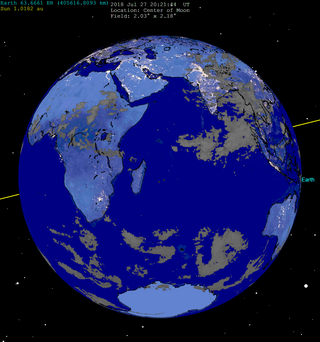July 2018 lunar eclipse: Difference between revisions
Rotation4020 (talk | contribs) Reverted 2 edits by 200.124.206.29 (talk). (TW) |
Fixed typo Tags: canned edit summary Mobile edit Mobile web edit |
||
| Line 2: | Line 2: | ||
! bgcolor=#e7dcc3 colspan=2|Total lunar eclipse<BR>July 27, 2018 |
! bgcolor=#e7dcc3 colspan=2|Total lunar eclipse<BR>July 27, 2018 |
||
|- |
|- |
||
| align=center colspan=2|Ecliptic north up<BR>[[File:Lunar eclipse chart close-2018Jul27.png|250px]]<BR>The moon will pass through the |
| align=center colspan=2|Ecliptic north up<BR>[[File:Lunar eclipse chart close-2018Jul27.png|250px]]<BR>The moon will pass through the centre of the Earth's shadow. |
||
|- |
|- |
||
|align=center bgcolor=#c0d0e0| [[Saros cycle]] || 129 (38 of 71) |
|align=center bgcolor=#c0d0e0| [[Saros cycle]] || 129 (38 of 71) |
||
Revision as of 21:56, 14 July 2018
| Total lunar eclipse July 27, 2018 | |
|---|---|
Ecliptic north up The moon will pass through the centre of the Earth's shadow. | |
| Saros cycle | 129 (38 of 71) |
| Gamma | +0.1168 |
| Duration (hr:mn:sc) | |
| Totality | 1:42:57 |
| Partial | 3:54:32 |
| Penumbral | 6:13:48 |
| Contacts (UTC) | |
| P1 | 17:14:49 |
| U1 | 18:24:27 |
| U2 | 19:30:15 |
| Greatest | 20:21:44 |
| U3 | 21:13:12 |
| U4 | 22:19:00 |
| P4 | 23:28:37 |
A total lunar eclipse will occur on July 27, 2018. The Moon will pass through the center of the Earth's shadow. This will be the first central lunar eclipse since June 15, 2011.
Since it will occur near apogee, this eclipse will also be the longest total lunar eclipse in the 21st century. Totality will last approximately 103 minutes.[1]
This eclipse will be the second total lunar eclipse in 2018, after the one in January.
Visibility
It will be completely visible over Eastern Africa, and Central Asia, seen rising over South America, Western Africa, and Europe, and setting over Eastern Asia, and Australia.
 View of Earth from Moon at greatest eclipse |
 Visibility map |
Background
A lunar eclipse occurs when the Moon passes within Earth's umbra (shadow). As the eclipse begins, Earth's shadow first darkens the Moon slightly. Then, the shadow begins to "cover" part of the Moon, turning it a dark red-brown color (typically – the color can vary based on atmospheric conditions). The Moon appears to be reddish because of Rayleigh scattering (the same effect that causes sunsets to appear reddish) and the refraction of that light by Earth's atmosphere into its umbra.[2]
The following simulation shows the approximate appearance of the Moon passing through Earth's shadow. The Moon's brightness is exaggerated within the umbral shadow. The northern portion of the Moon was closest to the center of the shadow, making it darkest, and most red in appearance.
Related eclipses
Lunar year series
| Lunar eclipse series sets from 2016–2020 | ||||||||
|---|---|---|---|---|---|---|---|---|
| Descending node | Ascending node | |||||||
| Saros | Date | Type Viewing |
Gamma | Saros | Date Viewing |
Type Chart |
Gamma | |
| 109 | 2016 Aug 18
|
Penumbral
|
1.56406 | 114
|
2017 Feb 11
|
Penumbral
|
−1.02548 | |
119
|
2017 Aug 07
|
Partial
|
0.86690 | 124
|
2018 Jan 31
|
Total
|
−0.30143 | |
129
|
2018 Jul 27
|
Total
|
0.11681 | 134
|
2019 Jan 21
|
Total
|
0.36842 | |
139
|
2019 Jul 16
|
Partial
|
−0.64300 | 144
|
2020 Jan 10
|
Penumbral
|
1.07270 | |
| 149 | 2020 Jul 05
|
Penumbral
|
−1.36387 | |||||
| Last set | 2016 Sep 16 | Last set | 2016 Mar 23 | |||||
| Next set | 2020 Jun 05 | Next set | 2020 Nov 30 | |||||
Saros series
Lunar saros series 129, repeating every 18 years and 11 days, containing 71 events, has 11 total lunar eclipses. The first total lunar eclipse of this series was on May 24, 1910, and last will be on September 8, 2090. The longest occurrence of this series was on July 16, 2000 when totality lasted 106 minutes and 24.6 seconds.
| Greatest | First | |||
|---|---|---|---|---|
 The greatest eclipse of the series occurred on 2000 Jul 16, lasting 106 minutes. |
Penumbral | Partial | Total | Central |
| 1351 Jun 10 | 1513 Sep 15 | 1910 May 24 | 1946 Jun 14 | |
| Last | ||||
| Central | Total | Partial | Penumbral | |
| 2036 Aug 7 | 2090 Sep 8 | 2469 Apr 26 | 2613 Jul 24 | |
| 1910 May 24 | 1928 Jun 3 | 1946 Jun 14 | |||

|

|

|

|

|

|
| 1964 Jun 25 | 1982 Jul 6 | 2000 Jul 16 | |||

|

|

|

|

|

|
| 2018 Jul 27 | 2036 Aug 7 | 2054 Aug 18 | |||

|

|

|

|

|

|
| 2072 Aug 28 | 2090 Sep 8 | ||||

|

|

|

| ||
See also
Notes
- ^ https://earth-chronicles.com/space/in-2018-the-longest-lunar-eclipse-will-take-place-in-100-years.html
- ^ Fred Espenak; Jean Meeus. "Visual Appearance of Lunar Eclipses". NASA. Retrieved April 13, 2014.
{{cite web}}: Unknown parameter|last-author-amp=ignored (|name-list-style=suggested) (help)
External links
- Where to see the eclipse and public events (Go Stargazing)
- 2018 Jul 27 chart: Eclipse Predictions by Fred Espenak, NASA/GSFC
- Hermit eclipse: 2018-07-27


